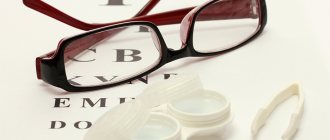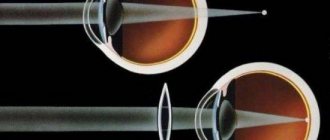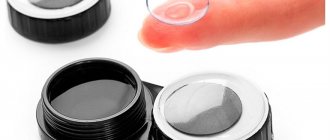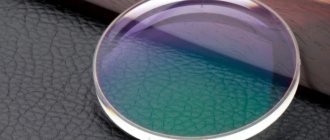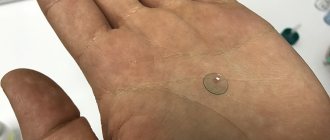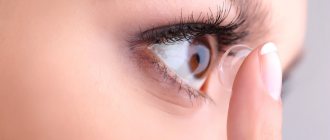Poor vision causes discomfort and makes a person completely helpless in many situations. One way to solve the problem is to use glasses. How to choose the right device for vision correction and which lenses - glass or plastic - to give preference to is described in this article.
Share
Tweet
Share
Cool
Send
Definition of polymer lenses
Polymer spectacle lenses are lenses made from transparent organic plastics.
The most commonly used polymer is CR-39 . However, most manufacturers assign their own names to polymers.
Every year the popularity of such products is growing and polymer glasses are gradually replacing optics with mineral lenses from the market.
Modern technologies for the eyes - polymer lenses
In the manufacture of organic lenses, in addition to plastic, special additives are used . Depending on the manufacturing method and structure, they are divided into two types: thermoplastics and thermosets. Thermoplastics are manufactured using injection molding. The most common material is polycarbonate . Its popularity is explained by the fact that polycarbonate is characterized by high resistance to mechanical damage.
The most popular CR-39 belongs to thermosets. According to its characteristics, the material is practically no different from glass . By adding other monomeric substances, CR-39 can be given additional properties, e.g. increase the amount of refraction.
The most modern polymer materials are tribrid and tryvex . They combine all the advantages of CR-39 and polycarbonate - they have excellent refractive index and are shock-resistant.
Pros of polymer lenses
Some believe that polymer optics are inferior in characteristics to mineral optics, for example, they do not have the same transparency. But modern polymers are not inferior to glass in their optical performance .
In addition, plastic products have a number of advantages :
- Light weight. Thanks to this, polymer glasses can be worn for a long time without experiencing discomfort.
- Plastic does not transmit ultraviolet radiation.
- Impact resistance and safety . Plastic can withstand shock loads. This is because plastic is a viscous material. Upon impact, it will not break into several fragments, which avoids possible eye injury.
- They have a high refractive index. This solved the problem of thick products. Organic glasses are thin, light and elegant.
- Plastic can be painted any color. This allows you to produce optics with any design.
Important! In many countries, almost all optics are made with organic lenses. This is due to the safety of this material. Glass glasses are used only by those people for whom they are recommended for medical reasons.
Minuses
The modern material has virtually no disadvantages; polymer optics have low abrasion resistance. If you wear glasses carelessly, they will quickly become covered with scratches.
A little about glasses: what are they made of and what are they needed for?
The word “glasses” comes from the word “oko”, that is, “eye”. Glasses are the most common optical device used for:
- correction of vision when it is impaired;
- protecting eyes from ultraviolet radiation and other harmful influences.
There are models that perform both functions simultaneously.
The device consists of the following parts:
- Two glass (mineral) or plastic (polymer) lenses.
- A metal or plastic frame holding them, consisting in turn of:
- two frames into which the optics are inserted;
- connecting the frames of a horizontal “bridge”;
- two temples (earhooks);
- two nose pads mounted on flexible hinges.
What is important to know when choosing glasses?
When starting to choose glasses, it is important to know what the differences are between different models. This will help you choose high-quality optics that are suitable in price and design, the owner of which will see clearly and feel comfortable.
Vision correction devices differ from each other in the following characteristics:
1. The coefficient (index) of light refraction. This is an important parameter that determines the quality of optics: the higher this indicator, the thinner the lens, but the number of diopters does not change.
2. Material of manufacture:
- glass;
- plastic.
3. The type of coating that improves the comfort and quality of vision and can be:
- single-layer strengthening, providing protection of polymer lenses from mechanical damage and allowing to extend their service life;
- antistatic, which is part of the complex coating and prevents the formation of static electricity and the attraction of dust to the surface of the lens;
- anti-reflective, single- or multi-layer, depending on the number of applied layers, increasingly providing maximum access of light to the eye, reducing the amount of reflected light and increasing image quality;
- water- and dirt-repellent (hydrophobic), applied last and increasing the resistance of the optics to moisture and contamination, reducing fogging when moving from cold to warm;
- anti-reflective (anti-reflex), preventing the appearance of surface glare on glass lenses and making them almost invisible, which gives the optics a stylish, modern look;
- multifunctional, consisting of several layers (for example, strengthening, anti-reflective, water- and dirt-repellent).
4. Design, which determines the design features of products, including their structure and the shape of the refractive surface:
- conventional spherical with a standard viewing angle;
- aspherical with a wide viewing angle;
- bifocal with division into 2 zones - for close and far distances;
- progressive, with a smooth transition from the zone for long distances to the zone for short distances.
Types of organic materials for spectacle lenses
Due to the fact that the pace of human life is becoming faster and faster, glasses must meet all the requirements. This led to the use of a large number of different materials for their manufacture.
For the manufacture of organic lenses the following are used:
- Polycarbonate - the material is lightweight, so it is often used for rimless glasses . It has good characteristics of optical refraction and resistance to mechanical damage. The structure of polycarbonate allows the production of very thin lenses.
- CR-39 is the most common material. Suitable for making glasses with small diopters . If the diopter value is over + or - 2, then the product will be quite thick.
- Trivex is a modern type of polymer with high optical refractive indexes. In terms of impact resistance, it is not inferior to polycarbonate. At the same time, it is lighter and has higher optical characteristics. It also has excellent resistance to chemicals. Trivex is excellent for making rimless optics.
- MR-10 is a modern advanced polymer with the highest refractive index. The material has excellent viscosity and elasticity. Therefore, lenses made from it are flexible and impact-resistant. In terms of impact resistance, it can be compared to polycarbonate . But at the same time it is much lighter and thinner. This explains the popularity of the polymer among leading manufacturers. It is used for the production of both standard and office and progressive glasses.
Glass lenses
Made from glass of inorganic origin. It is obtained from quartz sand . The material allows you to add various substances to it to improve the refractive index. Using compacting substances, it is possible to obtain a product with a refractive index of 1.9 . However, such optics will have quite a lot of weight.
Advantages
The advantages include:
- High abrasion resistance. This increases the service life of the product.
- It is possible to produce a thin lens with a refractive index of 1.9. With a large diopter value, glass lenses will be thinner than those made from polymers.
Flaws
- Low impact resistance. Under rough mechanical influence, glass glasses break into a large number of fragments. This makes them unsafe.
- Weight. Inorganic glasses weigh significantly more than the plastic version.
- Such products cannot be used to make models with rimless frames.
When choosing the most suitable material for making glasses, it is worth assessing the advantages and disadvantages of both glass and plastic. But modern polymer manufacturing technologies make this material more preferable.
Organic optics are not inferior in refraction to mineral optics. At the same time, it has excellent impact resistance; polymer models can replace 3 pairs of glasses. Therefore, such glasses are an ideal choice for children, athletes, motorists and office workers. And the ability to paint the polymer in any color allows you to get not only a high-quality, but also an original product.
Minus 10 years in 4 steps
Created pajamas for insomnia
Which lenses are best for whom?
Now, having examined in detail the advantages and disadvantages of both product groups, you can easily answer the question of which lenses are better to choose, plastic or glass.
For people who require significant vision correction, neatness, stylish appearance and comfort for the eyes are important, glass is perfect. It, as is already known, does not distort the image when worn for a long time, does not scratch, and is quite expensive, which will also emphasize its status.
For people who are accustomed to living easily and freely, who like to change something in their lives from time to time, who are accustomed to keeping up with fashion here and now, as well as those who require minor vision correction, or who are slightly careless, should choose plastic. These lenses will ensure comfortable wearing of glasses, allow you to choose any of the most fashionable and stylish frames, and will not break if accidentally dropped.
It is important not to forget the main thing: to buy glasses, whether for vision with diopters, sunglasses or regular ones, you need to buy them only in optics . Then the seller or ophthalmologist will recommend exactly what is needed in a particular case.
Medicine and healthComment

